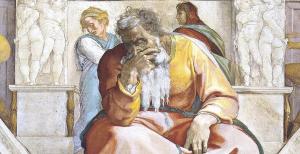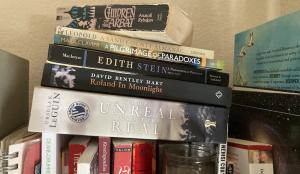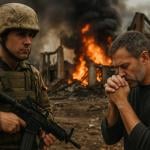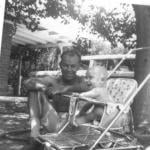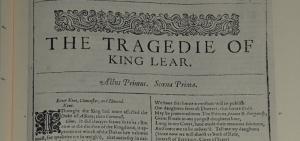
My travels this month gave me the unique opportunity to discuss tragedy, courage, and Shakespeare’s King Lear with a group of UK army chaplains. I called my talk “Lear’s Shadow.” The entire experience was unlike any other I’ve had in my life.
Tragedy at the Chapel
The invitation came from Fr. Deiniol Morgan, a chaplain based in London who, among many other responsibilities, organizes study days for his colleagues. His energy for building connections between art, theology, and the hard work of chaplaincy is impressive. Fr Deiniol’s prompt was for me to help open the play for these ministers who deal regularly with “issues such as family breakdown, love, justice, reconciliation, suicide, etc.” Lear, he knew, has plenty of space for all of that. After my talk and some time for “munching on sandwiches,” we would all leave for the Globe Theatre’s production of the play.
Not a bad way to spend a day in London!
The event took place in the barracks just across from Buckingham Palace. Fr. Deiniol met Stephanie and me at the gate and ushered us through security. He first took us into the Royal Military Chapel, a grand structure and a mashup of two architectural styles. The apse looks like it belongs in an old cathedral, but the nave clearly comes from the mid 20th century. Fr. Deiniol explained that the chapel was bombed on a Sunday morning in 1944, killing 121 of the people who had gathered for worship. The new nave was rebuilt out from the existing apse. This space knows something about tragedy, clearly.
The number of chaplains in attendance was lower than expected, as this was the first day of rail strikes in England. Fr. Deiniol suggested we take our coffee and chairs out onto the beautiful shaded lawn.
Lear’s Shadow
Once we settled and Fr. Deiniol had introduced me, I began to share with them some thoughts about the play. He had asked me to pay particular attention to the role of the Fool, which was a welcome prompt. The King’s Fool is one of the strangest and most compelling characters in the play. He is ironically among the wisest characters, and is especially important during the King’s descent into madness. I was only able to give the character minimal treatment in the Lear chapter of my book, so was feeling ready for the challenge.
My talk launched from a single, powerful, two word line delivered by Fool. “Lear’s shadow.”.
A little background will give the line some context.
Shakespeare’s Revision
We now have critical consensus that Shakespeare himself was the primary editor of his own Tragedy of King Lear. What we call Quarto Version, referring to the 4-fold pamphlet script written for the actors, first saw wide publication in 1608. A heavily edited version eventually made its way into the Folio, or collected plays, after his death.
There are many differences between the two versions, some of them easy to explain as corrections that keep the plot coherent, others that are more difficult to fathom. For me, though, the most brilliant of the edits comes in one of the King’s early speeches. The first version has Lear giving a speech of defiant anger to his daughter Goneril. He asks, rhetorically, “Who is it that can tell me who I am? Lear’s Shadow?” He then goes on, half comically, to suggest that he must be his own shadow, because the flesh and blood Lear has faithful daughters while he himself has none. The speech is aggressive, self-assured, and self-absorbed.
But Shakespeare’s revision makes a single important change. Lear’s speech stops at the question, “Who is it that can tell me who I am?” This time it’s the Fool who answers. “Lear’s shadow.”
Who Lear Is
It’s a remarkable moment in the play. We did a reading of both versions together, there on the barracks lawn, and you could feel the epiphany hit all at once. When the Fool has the line, the whole thing changes. Now Lear is pitiful, hurt, lost. His question is real, his crisis is existential. And the Fool speaks a word of wisdom to him.
In fact, I suggested, the line has a double meaning, one of Shakespeare’s favorite devices in both comedy and tragedy. The Fool is saying, as Lear himself was more or less saying in the first version, “you are a shadow of the King.” That’s important enough, fits with much of the play’s imagery, and is exactly what Lear needs to hear from his wise fool. You are not yourself.
But there’s more to it, I suggested to the chaplains. A play that turns on betrayal and manipulation and foolishness also holds threads of faithfulness, compassion, and forgiveness. There is a loyal servant whom Lear banishes, but who returns in disguise so he can serve his king. There is a daughter who remains faithful despite her banishment as well, and in some versions—including the current Globe production, she also returns in disguise, as the Fool. Even without this twist, the Fool himself is a faithful shadow, speaking courageous and comical wisdom from the king’s side. Even when Lear doesn’t want to hear it.
These characters are, I said, something like Wendy from Peter Pan: through their presence, they try to stitch Lear’s shadow back onto his body.
The Hope of the Tragedy
The play is not a happy one, to say the least. In fact, as I put it in my book, the painful ending becomes a way of “keeping God offstage,” or refusing a contrived optimism. I think that’s part of what the playwright is up to here. Asking us what we’re left with if the world is mean and ugly. If family and trusted friends betrays us. If even God refuses to show up and make things right.
The answer, I think, is in the Fool’s response. In such an ugly world, who can tell us the truth about who we are? Our shadows. This is the only thing that leaves me feeling hope at the end. That ugly world is also filled with loyal friends, with compassionate children ready to forgive. Other creatures surround the victims of pain, ready to stitch their true shapes back onto their feet.
This can seem like cold comfort when the cruel ones can do such harm. But Lear doesn’t let us leave with easy answers of any sort. It’s not happiness that wins, but it’s not the cruelty either. Even while we’re choking back the tears, those moments of grace and faithfulness hover over the play’s end.
The God of Lear is builder of a universe in which cruelty tries but never quite succeeds in destroying the beauty of faithfulness and mercy.
Reading Shakespeare with the Army
Our day at the barracks began with adversity and ended with disappointment. Fr. Deiniol got a call midmorning from the Globe, saying that half the cast had come down with Covid and so the performance had been cancelled.
We made the best of it. We munched our sandwiches, then they asked Stephanie, who has a PhD in counselor education and teaches at Seminary of the Southwest, to lead them in a conversation about mental health and chaplaincy work.
Then we returned to Lear, newly contemplating the traumas and trials of the ministerial vocation. We concluded with a spirited reading of three pivotal scenes. As we read the King’s dying lines, I glanced around. There we were, outside Buckingham Palace, under old sycamores that provided us a little oasis in the brilliant and busy city center. We were gathered in a circle of men and women who now felt like friends. We’d been honest, creative, and vulnerable with each other. We’d had some hard laughs as well. And of course we’d stopped for tea and biscuits.
All in all, not a bad way to spend a day in London.



